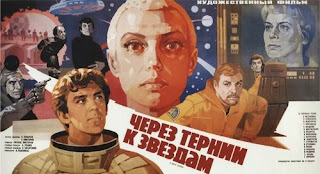To the Stars the Hard Way (1981)
What do a beautiful clone woman, an evil capitalist midget, a pun-spinning robot, a sentient octopus, environmentalism, a space cat, mind control, and Star Trek-esque aesthetics all have in common? Simple. All these and more are found within this 1981 Soviet sci-fi classic, To the Stars the Hard Way. Best known to American audiences through MST3K as the bastardized Humanoid Woman, To the Stars the Hard Way tells the story of Neeya, a clone found in a bombed out space station by an expedition. She is brought back to Earth and moves in with the perfect family of the future of the scientist who found her, Sergei, where they try to piece together exactly where she came from and what she was created for. Turns out Neeya comes from Dessa, a planet on the brink of extension due to the horrific environmental rape by its inhabitants, and must stop the evil capitalist midget who is trying to prevent the Earthlings from restoring ecological balance to the planet. If all that sounds ridiculous, well, it is, but To the Stars the Hard Way transcends the bizarre potluck of elements that make it up into a work of sublime beauty. For the USSR circa 1981, this was the equivalent of Star Wars. The special effects are certainly cheesy, but also trippy and surreal in their own unique way. What makes the film work is the storytelling, which is surprisingly very engaging. Neeya's journey of self-discovery is quite emotional and even etheral. Watching this recalls the great pulp science fiction stories of yore, with their fantastic and utopian depictions of the future, caricatured villains, and bombastic scenarios. The film's anticapitalist and environmental sentiments also recall H.G. Wells' tracts on the future of mankind. But in a break with the typically Soviet themes, there is also a strong message here about individualism, free will, and personal choice. This is a film that shows us what we can become, rather than what we are. It is also hallucinatory, boasting gorgeous colors and extravagant set pieces. There are also a few versions of the film. The one I watched is the original 140 minute cut, but there is also a two-hour restoration that was put together by the director's son. Whichever version one chooses to watch, this is essential viewing for anyone who loves good science fiction.


Comments
Post a Comment